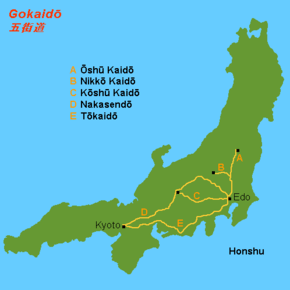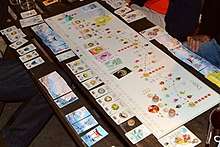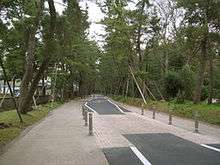Tōkaidō (road)
The Tōkaidō road (東海道, Tōkaidō), which roughly means "eastern sea route," was the most important of the Five Routes of the Edo period in Japan, connecting Kyoto to Edo (modern-day Tokyo). Unlike the inland and less heavily travelled Nakasendō, the Tōkaidō travelled along the sea coast of eastern Honshū, hence the route's name.[2]
| Tōkaidō | |
|---|---|
| (東海道, East Sea Road) | |
 The Five Routes, the Tōkaidō being the southernmost route | |
| Route information | |
| Established by Tokugawa shogunate | |
| Length | 514 km[1] (319 mi) |
| Time period | Edo |
| Cultural significance | Most important road connecting Japan's two largest cities |
| Related routes | The Five Routes |
| Restrictions | Permit required to travel beyond each check station |
| Major junctions | |
| West end | Sanjō Ōhashi in Kyoto, Japan |
| East end | Edobashi in Edo, Japan |
| Highway system | |
| National highways of Japan Expressways of Japan | |
Traveling the Tōkaidō
The standard method of travel was by foot, as wheeled carts were almost nonexistent and heavy cargo was usually sent by boat. Members of the higher class, however, travelled by kago. Women were forbidden to travel alone and had to be accompanied by men. Other restrictions were also put in place for travellers, but, while severe penalties existed for various travel regulations, most seem not to have been enforced.

Along the Tōkaidō, there were government-sanctioned post stations (shukuba) for travellers' rest. These stations consisted of porter stations and horse stables, as well as lodging, food and other places a traveller may visit. The original Tōkaidō was made up of 53 stations between the termination points of Edo and Kyoto. The 53 stations were taken from the 53 Buddhist saints that Buddhist acolyte Sudhana visited to receive teachings in his quest for enlightenment.[3] The route passed through several provinces, each administered by a daimyō, the borders of whose regions were clearly delineated. At numerous checkpoints set up by the government, travellers had to present travelling permits in order to pass onward.
There were almost no bridges over the larger, fast-flowing rivers, forcing travelers to be ferried across by boat or be carried by watermen porters. Additionally, at one point in Nagoya the road was barred by several rivers and voyagers had to take a boat across the sea for 17 miles to reach Kuwana station. These water crossings were a potential source of delay: In ideal weather the entire Tōkaidō journey on foot could be made in about a week, but if conditions were bad a trip might take up to a month.[4]
The Tōkaidō in art and literature

Travel, particularly along the Tōkaidō, was a very popular topic in art and literature at the time. A great many guidebooks of famous places were published and distributed at this time, and a culture of virtual tourism through books and pictures thrived. Jippensha Ikku's Tōkaidōchū Hizakurige, translated as "The Shank's Mare", is one of the more famous novels about a journey along the Tōkaidō.
The artist Hiroshige depicted each of the 53 Stations of the Tōkaidō (shukuba) in his work The Fifty-three Stations of the Tōkaidō, and the haiku poet Matsuo Bashō travelled along the road.[5] The Tōkaidō gojūsan tsui (Fifty-Three Pairings along the Tōkaidō Road), created in 1845, is one of the most well-known and fascinating examples of woodblock prints inspired by the road. Japan's three leading print designers of the nineteenth century—Kuniyoshi, Hiroshige, and Kunisada—paired each Tōkaidō rest station with an intriguing, cryptic design.
.jpg)
Due to the harsh and punitive Tenpō-era reforms which attempted to impose a strictly defined morality, prints of celebrity actors, courtesans, and entertainers were outlawed during this time. Crafted to outwit the artistic restrictions imposed by the reforms, the woodcuts in the Parallel Series became popular visual puzzles that were frequently reproduced. Because of the ingenious approach to the Tōkaidō theme, the Tōkaidō gojūsan tsui has been praised as one of the most innovative and important works from the late Edo period. Its three designers followed their individual interests and strengths, and yet shared a common composition—dominant figures against distant landscapes. They used a variety of motifs, including stories from kabuki theater, poetry, famous tales, legends, landmarks, and local specialties.[6]
In the early 1980s, inspired by Hiroshige, American artist Bill Zacha travelled the Tokaido stations. He created a series of 55 serigraphs, each depicting one stop along the Tokaido way, and printed 100 copies of each design. These were collected in the 1985 book Tokaido Journey, along with Bill's recollections (in both English and Japanese) of travelling the road and the people he encountered.[7]
The British painter Nigel Caple travelled along the Tōkaidō Road between 1998 and 2000, making drawings of the 53 stations along the Tōkaidō. His inspiration was the Hoeido Edition of woodblock prints entitled The Fifty-three Stations of the Tōkaidō by Utagawa Hiroshige. These drawings by Nigel Caple formed the basis for a series of paintings and culminated in a touring exhibition and lectures during 2001 and 2002. Locations included Hertfordshire University and The British Museum. The exhibition was part of the UK’s Japan Festival 2001.[8]
The video game Tōkaidō Gojūsan-tsugi, released by Sunsoft for the Famicom in July 1986 and later ported to other Nintendo platforms, features a firework maker protagonist who must travel the Tōkaidō to visit his fiancee, while thwarting attacks from a rival businessman.

The 2012 board game Tōkaidō, designed by Antoine Bauza, is set in the Edo period. Players can take on the roles of artists travelling the East Sea Road, assembling, among other things, panoramas of its views as they journey toward Edo.
Ōsaka Kaidō
In 1619, the Ōsaka Kaidō (大阪街道) was established as a spur of the Tōkaidō; it had four stations of its own after Ōtsu-juku. This addition extended the route to Kōraibashi in Osaka. This spur was also called the Kyōkaidō (京街道), or it was described as being a part of the 57 stations of the Tōkaidō.
Modern-day Tōkaidō

Today, the Tōkaidō corridor is the most heavily travelled transportation corridor in Japan, connecting Greater Tokyo (including the capital Tokyo as well as Japan's second largest city Yokohama) to Nagoya (fourth largest), and then to Osaka (third largest) via Kyoto. The Tokyo-Nagoya-Kyoto-Osaka route is followed by the JR Tōkaidō Main Line and Tōkaidō Shinkansen, as well as the Tōmei and Meishin expressways. A few portions of the original road can still be found, however, and in modern times at least one person has managed to follow and walk much of it.[9]
See also
References
- Pepe, Sensei Mike. "The Tokaido Road". Sessa Kai Shorin-Ryu Karate Dojo Watertown MA. Sessa Kai Dojo. Retrieved March 11, 2017.
- Turnbull, Stephen (1987). Battles of the Samurai. Arms and Armour Press. p. 31. ISBN 0853688265.
- "Archived copy". Archived from the original on 2004-10-28. Retrieved 2004-10-28.CS1 maint: archived copy as title (link)
- Narazaki, Muneshige (1969). Masterworks of Ukiyoe: The 53 Stations of the Tokaido. Tokyo & Palo Alto: Kodansha International Ltd. ISBN 0-87011-087-X.
- Forbes, Andrew; Henley, David (2014). Utagawa Hiroshige's 53 Stations of the Tokaido. Chiang Mai: Cognoscenti Books. B00LM4APAI (full series of Hiroshige prints and selection of Tokaido haiku from Matsuo Basho).
- Marks, Andreas, ed. (2015). Tōkaidō Texts and Tales: Tōkaidō gojūsan tsui by Hiroshige, Kunisada, and Kuniyoshi. University of Florida, Samuel P. Harn Museum of Art: University Press of Florida. pp. http://www.upf.com/book.asp?id=STEUB004. ISBN 978-0-8130-6021-7.CS1 maint: extra text: authors list (link)
- Swartz, Susan (December 17, 1995), "The artist who put Mendocino on the map", Santa Rosa Press-Democrat.
- Exhibition catalogue, The 53 Stations of the Tokaido Road Paintings by Nigel Caple, edited by Matthew Shaul, published by UH Galleries (University of Hertfordshire Galleries), 2001. ISBN 1898543658. (A copy of this catalogue is held within The British Council Library collection).
- Carey, Patrick. Rediscovering the Old Tokaido: In the Footsteps of Hiroshige, Global Oriental, Folkestone, England, 2000.
- Traganeou, Jilly. 2004. The Tokaido Road: Traveling and Representation in Edo and Meiji Japan. London: RoutledgeCurzon. ISBN 978-0-415-31091-8 (cloth)
- Vaporis, Constantine Nomikos. 1994. Breaking Barriers. Travel and the State in Early Modern Japan." Cambridge, Massachusetts: Harvard University Press. ISBN 0-674-08107-2 (https://www.amazon.com/Breaking-Barriers-Travel-Harvard-Monographs/dp/0674081072/ref=sr_1_1?ie=UTF8&s=books&qid=1219068536&sr=8-1)
External links
| Wikimedia Commons has media related to Tōkaidō (road). |
- Walk the Tōkaidō - an interactive tour down the road.
- Travel Tōkaidō - from U.S. Public Broadcasting Service (PBS)
- The Old Tōkaidō: The Eastern Sea Road - Teacher James Baquet's log of a walk along the entire Tōkaidō, with photos and comparisons to Hiroshige's prints.
- The Fifty Three Stations of the Tokaido Road - hiroshige.org.uk, an online archive of the various editions of Hiroshige's prints
- Tōkaidō Texts and Tales: Tōkaidō gojūsan tsui by Hiroshige, Kunisada, and Kuniyoshi. Andreas Marks, ed. (University Press of Florida, 2015)
- The Fifty Three Stations of the Tokaido Represented as Cats - by Utagawa Kuniyoshi